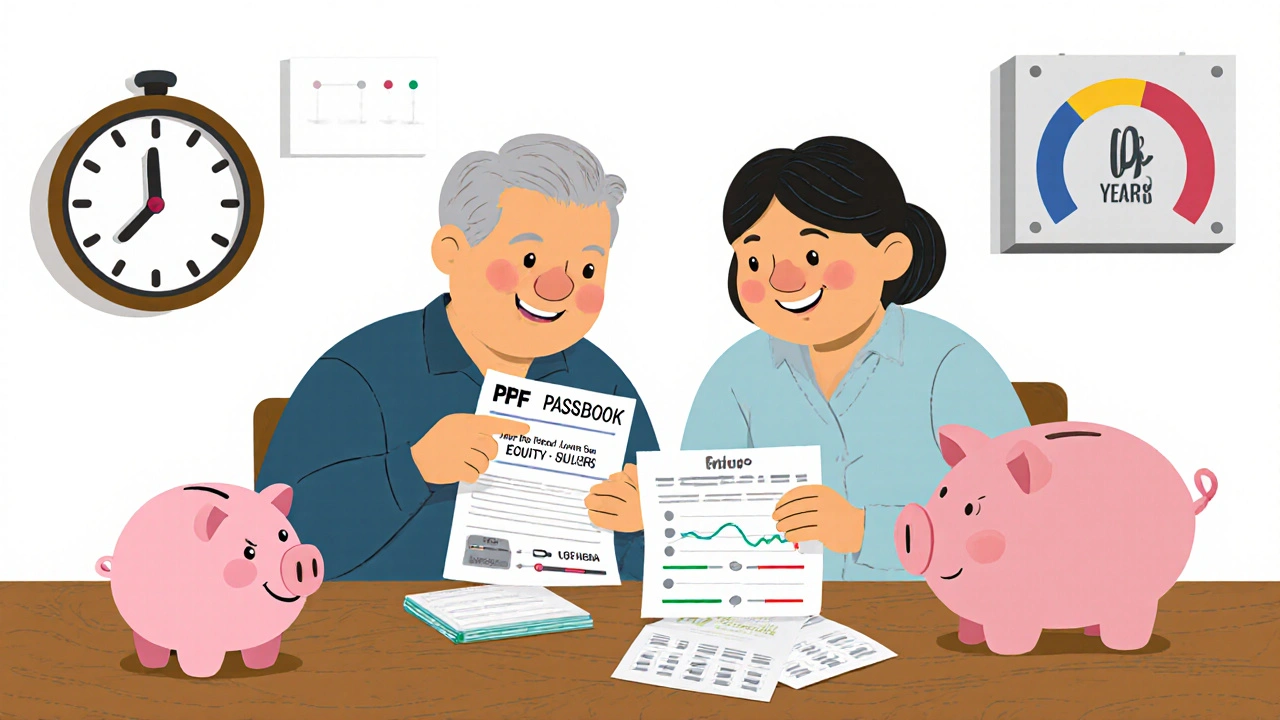NPS vs PPF in India: Which Retirement Scheme Is Better for Your Goals?
If you're planning for retirement in India, you've probably heard of NPS and PPF. Both are government-backed, tax-friendly ways to save money for your later years. But which one actually works better for you? It’s not about which is ‘better’ overall-it’s about which matches your goals, risk tolerance, and how much control you want over your money.
What Is NPS?
NPS stands for National Pension System. It’s a retirement scheme launched by the Indian government in 2004, open to all citizens, including self-employed people and those in the private sector. You contribute money regularly, and it gets invested in a mix of assets: equities, corporate bonds, and government securities. The amount you get back at 60 depends on how much you put in and how those investments performed.
There are two types of accounts under NPS: Tier I (mandatory, locked until retirement) and Tier II (voluntary, flexible withdrawals). You can choose how to split your contributions between equity (up to 75%), corporate bonds (up to 20%), and government securities (up to 100%). That means you have direct control over your risk level.
For example, if you’re 30 and comfortable with market ups and downs, you might put 70% in equity. If you’re 50 and want to protect your savings, you might shift to 80% in government bonds. The system automatically reduces your equity exposure as you get closer to retirement.
What Is PPF?
PPF, or Public Provident Fund, has been around since 1968. It’s a fixed-income, long-term savings scheme with guaranteed returns. You open an account at a bank or post office, deposit money every year (minimum ₹500, maximum ₹1.5 lakh), and earn a fixed interest rate set by the government each quarter. For 2025, the rate is 7.1% per year, compounded annually.
The lock-in period is 15 years, but you can extend it in blocks of five years after that. You can withdraw partial amounts after the 7th year, and loans are allowed between the 3rd and 6th year. The entire maturity amount-your deposits plus interest-is completely tax-free under Section 80C and Section 10(11).
PPF is simple. No market risk. No investment choices. Just put in your money, and the government pays you interest. It’s the kind of savings plan your parents or grandparents might have used-and it still works today.
Return Comparison: NPS vs PPF
Here’s where people get confused. PPF gives you a fixed return. NPS gives you variable returns based on market performance.
Over the last 10 years, NPS equity-heavy portfolios have averaged 9-11% annual returns. Conservative portfolios (mostly bonds) returned around 7-8%. PPF has hovered between 7.1% and 8.7% over the same period.
But here’s the catch: NPS returns aren’t guaranteed. In 2020, during market crashes, some NPS portfolios dropped by 12% in a single quarter. PPF? Still paid 7.7% regardless.
Let’s say you invest ₹1.5 lakh every year for 30 years:
- With PPF at 7.1%, you’d end up with about ₹1.62 crore at age 60.
- With NPS at 9% average return, you’d have around ₹2.15 crore.
- With NPS at 11% (strong market years), you’d hit ₹2.8 crore.
That’s a difference of up to ₹1.2 crore. But that higher return comes with volatility. If the market tanks in your final five years, your pension pot could shrink significantly.
Tax Benefits: NPS vs PPF
Both offer tax deductions under Section 80C (up to ₹1.5 lakh per year). But NPS has an extra perk: you can claim an additional ₹50,000 under Section 80CCD(1B), bringing your total deduction to ₹2 lakh.
At retirement, the rules differ:
- With PPF: 100% of the maturity amount is tax-free.
- With NPS: Only 40% of the corpus can be withdrawn tax-free. The remaining 60% must be used to buy an annuity (a monthly pension). Of that annuity income, 40% is taxable.
So if you withdraw ₹2 crore from NPS at 60, you can take ₹80 lakh tax-free. The other ₹1.2 crore goes into an annuity. You’ll pay tax on the monthly payouts you receive-just like a salary.
PPF gives you the full amount, tax-free, all at once. No strings attached.
Flexibility and Access
PPF is rigid. You can’t touch the money before 15 years without penalties. Even after that, withdrawals are limited. You can’t close the account early unless you’re moving abroad or facing critical illness.
NPS gives you more flexibility. Tier II account lets you withdraw anytime. Tier I allows partial withdrawals for specific reasons: medical emergencies, children’s education, home purchase, or marriage. You can make up to three withdrawals during your entire tenure.
And when you retire, NPS lets you choose your annuity provider. You can pick from LIC, SBI, HDFC, or others. You can even opt for a higher monthly payout with a shorter term, or a smaller one that lasts your whole life.

Who Should Choose NPS?
NPS makes sense if:
- You’re comfortable with market risk and want higher long-term growth.
- You want to actively manage your investments (or at least choose your asset mix).
- You’re earning a salary and can afford to lock in ₹2 lakh annually for tax savings.
- You don’t mind receiving monthly pension payments instead of a lump sum.
It’s ideal for young professionals in their 20s or 30s who have 30+ years until retirement and can ride out market swings.
Who Should Choose PPF?
PPF is better if:
- You want guaranteed returns and zero risk.
- You prefer a lump sum at retirement to manage as you wish.
- You’re risk-averse or nearing retirement and don’t want market exposure.
- You want simplicity-no choices, no monitoring, no fees.
It’s perfect for salaried employees who want a safe, predictable backup, or for parents saving for their child’s future (PPF accounts can be opened for minors).
Can You Have Both?
Yes. Many people use both. Use PPF for your core, guaranteed savings-say, ₹1.5 lakh per year. Then use NPS to add another ₹50,000 for the extra tax break and growth potential.
This hybrid approach gives you safety from PPF and upside from NPS. You get tax savings up to ₹2 lakh, a lump sum from PPF, and a steady pension from NPS. It’s a smart, balanced strategy.
What About Fees?
PPF has no fees. No account maintenance, no fund management charges. Your money grows untouched.
NPS charges fees: ₹35 per year for account maintenance, plus fund management fees of 0.0009% to 0.25% depending on your provider. Over 30 years, that adds up to roughly ₹15,000-₹25,000 in costs. It’s not much compared to your total corpus, but it’s something to know.

Real-Life Example: Priya, 32, IT Professional
Priya earns ₹18 lakh a year. She wants to retire at 60 with ₹3 crore. She invests ₹1.5 lakh in PPF every year. That’ll grow to ₹1.62 crore by 60. She adds ₹50,000 to NPS, choosing 60% equity, 40% bonds. After 28 years, her NPS corpus hits ₹95 lakh. Total retirement savings: ₹2.57 crore.
She’s close. To reach ₹3 crore, she increases her NPS contribution to ₹75,000/year. Now she hits her goal. She keeps PPF for safety and NPS for growth.
Final Decision Checklist
Ask yourself these questions:
- Do I want guaranteed returns or higher growth potential?
- Am I okay with monthly pension payments, or do I want a lump sum?
- Do I want to choose where my money is invested?
- Can I handle market volatility?
- Do I need access to funds before retirement?
If you answered ‘guaranteed’, ‘lump sum’, ‘no choices’, ‘no risk’, ‘no access’ → go with PPF.
If you answered ‘growth’, ‘monthly income’, ‘I want control’, ‘I can handle risk’, ‘some access’ → go with NPS.
Or better yet-use both.
What Happens If You Die Before Retirement?
With PPF: The entire balance goes to your nominee, tax-free.
With NPS: The entire corpus goes to your nominee. If your nominee is your spouse, they can continue the account. Otherwise, they receive the full amount as a lump sum.
Both are clear and straightforward. No legal hassles.
Bottom Line
PPF is the safe, simple, tried-and-true option. NPS is the dynamic, higher-reward option with more complexity. Neither is right for everyone. The best choice depends on your personality, risk appetite, and retirement vision.
Most people don’t need to pick one. They need both. Use PPF as your foundation. Use NPS to boost your returns and tax savings. Together, they cover safety, growth, and flexibility-exactly what a solid retirement plan needs.





